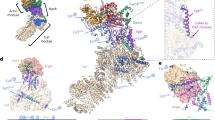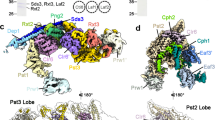Abstract
The N-terminal acetylation of Sir3 is essential for heterochromatin establishment and maintenance in yeast, but its mechanism of action is unknown. The crystal structure of the N-terminally acetylated BAH domain of Saccharomyces cerevisiae Sir3 bound to the nucleosome core particle reveals that the N-terminal acetylation stabilizes the interaction of Sir3 with the nucleosome. Additionally, we present a new method for the production of protein–nucleosome complexes for structural analysis.
This is a preview of subscription content, access via your institution
Access options
Subscribe to this journal
Receive 12 print issues and online access
$189.00 per year
only $15.75 per issue
Buy this article
- Purchase on Springer Link
- Instant access to full article PDF
Prices may be subject to local taxes which are calculated during checkout


Similar content being viewed by others
References
Bühler, M. & Gasser, S.M. EMBO J. 28, 2149–2161 (2009).
Buchberger, J.R. et al. Mol. Cell. Biol. 28, 6903–6918 (2008).
Cubizolles, F., Martino, F., Perrod, S. & Gasser, S.M. Mol. Cell 21, 825–836 (2006).
Ehrentraut, S. et al. Genes Dev. 25, 1835–1846 (2011).
Onishi, M., Liou, G.G., Buchberger, J.R., Walz, T. & Moazed, D. Mol. Cell 28, 1015–1028 (2007).
Wang, X., Connelly, J.J., Wang, C.L. & Sternglanz, R. Genetics 168, 547–551 (2004).
Ruault, M., De Meyer, A., Loiodice, I. & Taddei, A. J. Cell Biol. 192, 417–431 (2011).
Sampath, V. et al. Mol. Cell. Biol. 29, 2532–2545 (2009).
van Welsem, T. et al. Mol. Cell. Biol. 28, 3861–3872 (2008).
Armache, K.J., Garlick, J.D., Canzio, D., Narlikar, G.J. & Kingston, R.E. Science 334, 977–982 (2011).
Wang, F. et al. Proc. Natl. Acad. Sci. USA 110, 8495–8500 (2013).
Arnesen, T. PLoS Biol. 9, e1001074 (2011).
Connelly, J.J. et al. Mol. Cell. Biol. 26, 3256–3265 (2006).
Park, J.H., Cosgrove, M.S., Youngman, E., Wolberger, C. & Boeke, J.D. Nat. Genet. 32, 273–279 (2002).
Martino, F. et al. Mol. Cell 33, 323–334 (2009).
Luger, K., Mader, A.W., Richmond, R.K., Sargent, D.F. & Richmond, T.J. Nature 389, 251–260 (1997).
Kabsch, W. Acta Crystallogr. D Biol. Crystallogr. 66, 133–144 (2010).
Winn, M.D. et al. Acta Crystallogr. D Biol. Crystallogr. 67, 235–242 (2011).
Hou, Z., Danzer, J.R., Fox, C.A. & Keck, J.L. Protein Sci. 15, 1182–1186 (2006).
Vasudevan, D., Chua, E.Y. & Davey, C.A. J. Mol. Biol. 403, 1–10 (2010).
Afonine, P.V. et al. Acta Crystallogr. D Biol. Crystallogr. 68, 352–367 (2012).
Nicholls, R.A., Long, F. & Murshudov, G.N. Acta Crystallogr. D Biol. Crystallogr. 68, 404–417 (2012).
Acknowledgements
We thank G. Murshudov, F. Long, R. Nicholls, P. Emsley and H. Powell for troubleshooting and sharing tools for the software Refmac5, LibG, Prosmart, Coot and iMosflm. We thank M. Lamers and K. Nagai's laboratory for critical discussion of the results. We thank M. Yu for helping with the usage of the I24 beamlines at Diamond Light Source. F.M. is supported by the Swiss National Fund (PBGEP3-123695), a European Molecular Biology Organization Long Term Fellowship (ALTF419-2009) and a Marie Curie Intra European Long Term Fellowship (FP7-PEOPLE-2009-IEF-251794). N.A. is supported by the EU FP7 Marie Curie Initial training Nucleosome 4D network (4609511-238176). The project was supported by the UK Medical Research Council (MC-A025-5PJ80).
Author information
Authors and Affiliations
Contributions
D.R., F.M. and N.A. designed the experiments. F.M. and N.A. purified all the proteins, DNA and complexes used, prepared, optimized and cryoprotected the crystals, solved the structure and wrote the manuscript. I.S.F. froze the crystals. F.M., N.A. and I.S.F. collected the X-ray diffraction data. N.A. and S.H.M. performed the binding experiments. S.Y.P.-C. performed the MALDI. D.R. revised the manuscript.
Corresponding author
Ethics declarations
Competing interests
The authors declare no competing financial interests.
Supplementary information
Supplementary Text and Figures
Supplementary Figures 1–3 and Supplementary Table 1 (PDF 4433 kb)
Rights and permissions
About this article
Cite this article
Arnaudo, N., Fernández, I., McLaughlin, S. et al. The N-terminal acetylation of Sir3 stabilizes its binding to the nucleosome core particle. Nat Struct Mol Biol 20, 1119–1121 (2013). https://doi.org/10.1038/nsmb.2641
Received:
Accepted:
Published:
Issue Date:
DOI: https://doi.org/10.1038/nsmb.2641
This article is cited by
-
Epigenetics Identifier screens reveal regulators of chromatin acylation and limited specificity of acylation antibodies
Scientific Reports (2021)
-
Coupling of H3K27me3 recognition with transcriptional repression through the BAH-PHD-CPL2 complex in Arabidopsis
Nature Communications (2020)
-
A novel NAA10 p.(R83H) variant with impaired acetyltransferase activity identified in two boys with ID and microcephaly
BMC Medical Genetics (2019)
-
Retroviral integration into nucleosomes through DNA looping and sliding along the histone octamer
Nature Communications (2019)
-
Structure and function of the Orc1 BAH-nucleosome complex
Nature Communications (2019)



